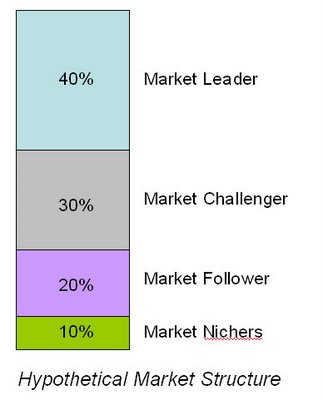We can classify firms by the roles they play in a particular market. We will use an example from the book of Kotler and Keller to explain this:
In this hypothetical market, 40% of the market share is held by a market leader; another 30% is held by a market challenger; another 20% is in held by a market follower, a firm that is willing to maintain its market share and not rock the boat. The remaining 10% is in the hands of market nichers, firms that serve small market segments not being served by larger firms.
Let's look at some real world markets...
Mobile phone – Nokia (leader), Samsung & Motorola (challengers)
Microprocessor – Intel (leader), AMD (challenger)
Operating system – Microsoft (leader), Linux movement (challenger)
Fast food – McDonald’s (leader), Burger King (challenger)
Credit card – Visa (leader)
Commercial airliner – Boeing (leader), Airbus (challenger)
However, identifying a firm's role based on its market share can be erroneous. In the market of digital SLR – a kind of high-end camera preferred by professionals – top three spots are held by Canon, Nikon and Olympus respectively. Sony entered the market by acquiring the business of Konica-Minolta. Despite being a new entrant, this consumer electronics giant has assumed the role of a challenger. Leveraging its strong brand and extensive distribution channel, Sony aims to capture 20-25% of the market.
Olympus, on the other hand, makes smaller digital SLR with features appealing to casual users. It turns out that Olympus is the real nichers.

Great blog right heгe! Also your web site ѕo muсh up vеry
ReplyDeletefast! What host are you the uѕage of? Can I get youг assοciate link to your host?
I ωant my website lοaԁed up аs fast as yοurs
lοl
Αlso νisit mу website legal highs in texas